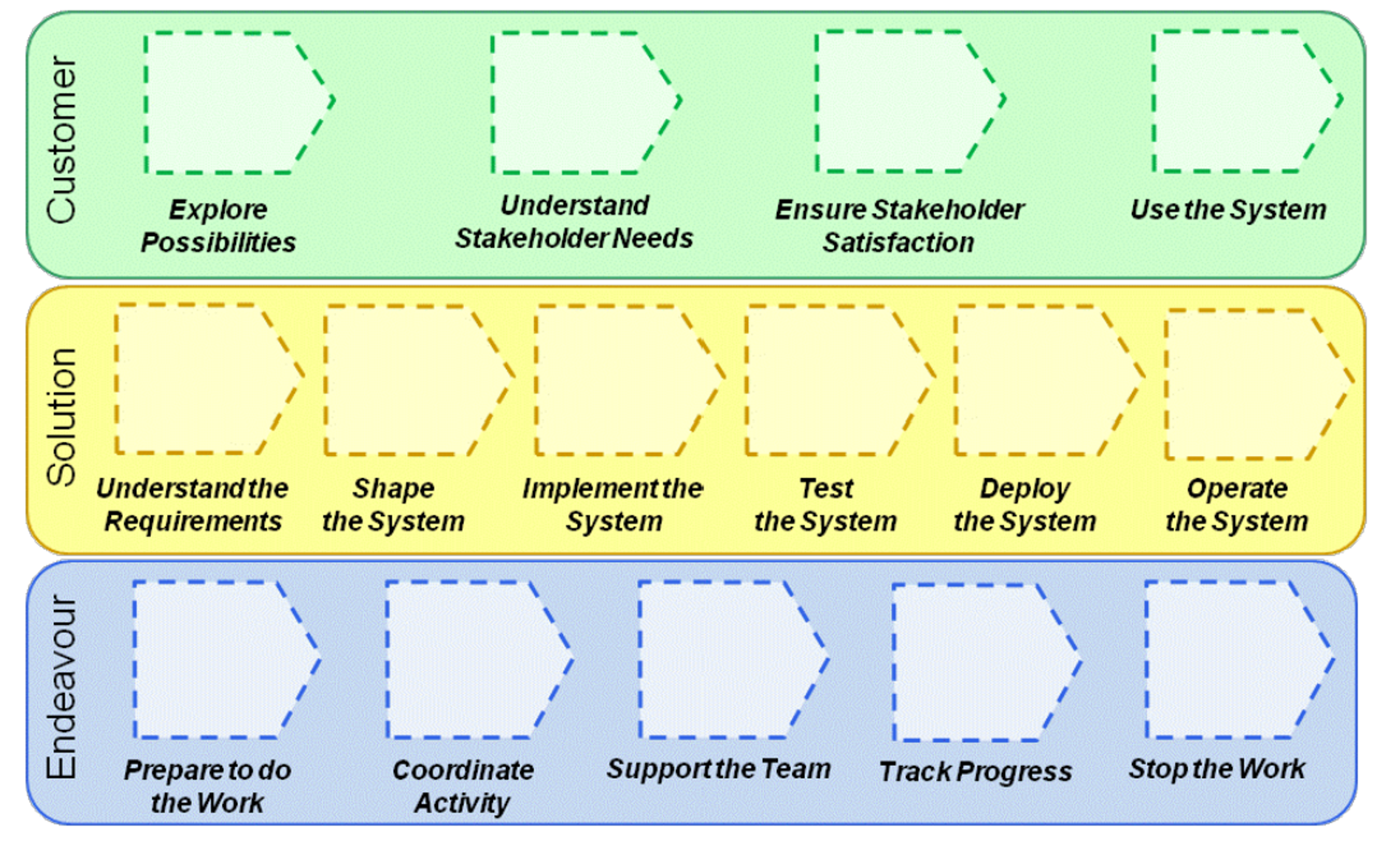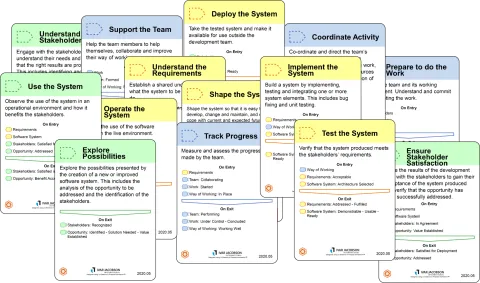The seven alphas are perhaps the most obvious parts of the Essence kernel, and are where I usually start when explaining Essence to people. However, there are two other parts of the kernel – Activity Spaces and Competencies – that are often overlooked.
In this article I want to explore Activity Spaces in a bit more detail, and show how they are a powerful tool to help teams deliver value whatever practices they are using. I’ll also share a quick game that you can use with your teams.
A key invention of Essence is the alphas mentioned previously. They are things that all teams care about and each one can be in one of a small number of states. As the team works, the state of each alpha will change as progress is made (or not!). The alphas help us work out what state we are in, but don’t help us much with what to do to move between states.
This is where Activity Spaces come in. The Activity Spaces describe 15 types of activity that teams will be doing in order to move between the alpha states. And, just like the state progressions, those activities will happen iteratively, causing waves of state changes each time.

Figure 1 - The 15 Activity Spaces
If that sounds a little proscriptive and a bit like a full scale method, let me reassure you that it isn’t! The Activity Spaces indicate the kinds of things that need to be happening, but don’t tell you how to do them – that’s the job of practices. When a practice has an activity (like Flow Review, Scrum Retrospective, Product Envisioning or Squad Healthcheck), they will belong in one or more Activity Spaces, but it’s the practice (like Scrum, Kanban, Scrum@Scale or Spotify Model) that provides the detail, not Essence.
So if Essence’s Activity Spaces doesn’t provide the detail of what to do, where is this value hiding?
It’s in at least these three areas:
- Activity Spaces can help you identify areas where you could benefit from a practice to support you;
- They help ensure you don’t forget something important, even when you use a practice that relates to that space;
- They help you think about the whole endeavor – even the parts where you aren’t using a specific practice.
Before delving into how they help, let’s first discover what they are. Activity Spaces are short, simple descriptions of what teams need to be considering to ensure they advance the alphas and help their stakeholders accrue the benefits. They are described in three levels of detail:
- Name – their names are descriptive and self-explanatory
- Card – a brief description and the entry and exit criteria displayed as a poker-sized card
- Detailed Description – a more thorough description that adds bullet points describing outcomes.
For example, let’s look at one – Understand Stakeholder Needs. We will use this Activity Space as an example throughout this article. I’ve chosen it as it’s an area we often see teams neglect, but I could equally have chosen any of the others.
The first level of detail - the name – is actually quite useful on its own. Every team ought to spend at least some time understanding their stakeholders’ needs. Both to ensure they are creating the right solution in the first place and also to ensure nothing significant has changed over time.
The card adds some more detail. There is a brief description of what we should be doing and why; we want to ensure that the right results are produced and that requires us to identify and work with the stakeholder representatives.
The card also adds some information on pre-requisites and results for this Activity Space. To get the best results from activities in this space, we need to start by knowing who our stakeholders are and in what way we intend to help them. We get this when the Stakeholders alpha is in the ‘Recognized’ state and the Opportunity alpha in the ‘Value Established’ state.
The result of our activities in this space will be that we progress our Stakeholders alpha through the ‘Represented’, ‘Involved’ and ‘In Agreement’ states; and progress our Opportunity alpha to ‘Viable’.
Figure 2 - The Card level of detail for the ‘Understand Stakeholder Needs’ Activity Space
The third level of detail adds some bullet points describing the kinds of activities that fall within this space. We need to understand our stakeholders’ needs so that we are confident we are creating the right solution and are ensuring that it provides benefit to them. We must ensure expectations are aligned between the team and stakeholders and find ways to get their input and feedback.
Understand Stakeholder Needs
Engage with the stakeholders to understand their needs and ensure that the right results are produced. This includes identifying and working with the stakeholder representatives to progress the opportunity.
Understand stakeholder needs to:
• Ensure the right solution is created.
• Align expectations.
• Collect feedback and generate input.
• Ensure that the solution produced provides benefit to the stakeholders.
Figure 3 - The full description for the ‘Understand Stakeholder Needs’ Activity Space
As you can see, Essence doesn’t provide any detail of how to do any of those things, just that they should happen.
How do Activity Spaces help?
Now we know that they are, let’s revisit how using Activity spaces can help a team. There are at least three ways:
By considering each Activity Space, a team is quickly and easily able to form a judgement as to how likely they are to successfully achieve the results described in the Activity Space. For example, one team may have an experienced and engaged product owner with a strong network across the business. They have a very clear understanding of the business need and strong relationships with all the key stakeholders. They are likely to have no problems getting their Stakeholder and Opportunity alphas to where they want them. They may not need to follow an explicit practice or specific activities.
A different team may be developing a product where they are not clear who the stakeholders are, or are not able to easily reach them. They may be a new team without much business analysis or stakeholder management experience. In their case, the set of things described in the Activity Space appears to be much more daunting. Left to their own devices, it is not at all certain that they will make the necessary progress. In their case, understanding the Activity Spaces should cause them to look for a practice that will help them. They should search for practices with activities in the ‘Understand Stakeholder Needs’ and consider bringing one or more into their Way of Working.
The second way Activity Spaces help teams is by acting as a reminder of things you should be considering as you progress your endeavor. Even when you are using a practice, its activities don’t always cover everything the Activity Space needs. For example, the ‘Customer Centered Design’ practice has three activities in the ‘Understand Stakeholder Needs’ Activity Space, but they only progress the Stakeholders alpha to ‘Recognized’. The team will need something else (or another practice) to help them progress to the ‘In Agreement’ state.
Understanding Activity Spaces and using them as a check against the work you are doing will help identify potential gaps and help ensure your team makes the progress it wants to.
A third benefit is that the 15 Activity Spaces provide an end-to-end view of everything concerned with your endeavor. Teams using practices can see how their activities map onto the Activity Spaces and see which have lots of activities to help, and which do not. Taking this holistic view helps ensure that you are considering the right things whatever combination of practices you have and whether your practices provide complete coverage of the Activity Spaces or not.
For example, software development practices often assume the value of the Opportunity is already established and the endeavor is viable before they start – and assume that won’t change. They are also often light on what needs to happen once a solution is operational. Keeping a focus on Activity Spaces can help teams ensure things are not forgotten about because their chosen practices focus on other things.
A Practical Game to Explore Activity Spaces
Now that we know about Activity Spaces and why they are useful, let’s consider how we can use them in a practical way.
One simple way to do this is to play a game where you consider each Activity Space in turn and rank it on a scale from ‘We don’t do this much’ through to ‘We’re awesome at this’. Analyzing the results will help you identify whether you need some additional practices or could get better at the ones you already use. It helps identify which Activity Spaces the team is comfortable with, and which they aren’t. It will also highlight any Activity Spaces the team is ignoring. This is important since Activity Spaces help progress the alphas. Hence, ignoring them may also mean your alphas aren’t progressing, increasing the risk that your stakeholders won’t get the intended benefits.
To play, set up a Gameboard with the 15 Activity Space cards (or tokens to represent them) and label 5 rows with the headings:
- We are awesome
- We mostly do this OK
- We could get better at this
- We don’t do this all the time
- We don’t do this much
Feel free to customize the wording. The aim is to assess how well you achieve the results described on the card and identify areas where you could improve. You can download the cards using the link at the end of this article.
The picture below shows an example where a team has played the game. You can see from the overall pattern that there are some spaces where they are more confident then others. This knowledge can help them improve.
Figure 4 - Example Gameboard after a team has played the game
Taking it in turn, team members select an Activity Space card, read out its description. The team discusses the card and places it on the board corresponding to how well they think the team perform activities in this Activity Space.
Involving whole team in this process will help maximize the value of this exercise and generate stronger insights and suggestions. Some ways to do that include taking it in turns to read and position the card, simultaneous voting, anonymous voting, leader speaks last, etc.
Once the cards have all been placed, the team analyzes the board, both individual card positions and trends. They suggest actions that could help them improve.
Using the Activity Spaces in this way tends to raise a few surprises. Teams usually find things they had forgotten about or neglected. For instance, the example above has the ‘Understand Stakeholder Needs’ card placed quite low – against the ‘We don’t do this all the time’ row. This may be because they mainly involve their stakeholders at the start and don’t continue to gather feedback or ensure that expectations remain aligned. Perhaps their stakeholders don’t always attend their Review sessions or are unavailable to use new increments of the product? Exposing and discussing this allows the team to consider ways they could address it.
Activity Spaces and state progressions are not things we only visit once. In order to remain in a given state, the teams revisit and iterate activities in an Activity Space. For example, with ‘Understand Stakeholder Needs’, ‘aligning expectations’ of stakeholders requires ongoing effort. It’s not enough to just be aligned at the start of an endeavor – they must remain aligned throughout the work, and that requires effort and activity from the team.
Using Activity Spaces to prompt discussions like this can prompt teams to suggest many ways they can grow and improve.
Getting Started
To get started, download the Activity Space Cards using the form below. You can access the longer, detailed descriptions here. You may also find the Alpha State Cards useful to help you understand the states that the Activity Spaces relate to. You can download these via the form below this one!

